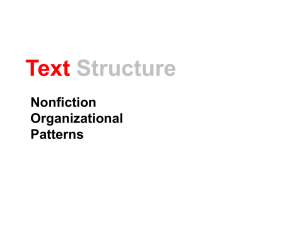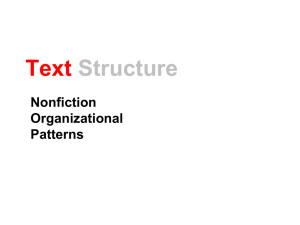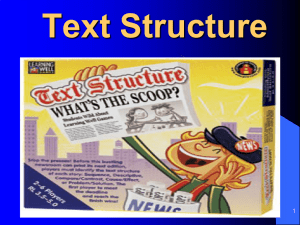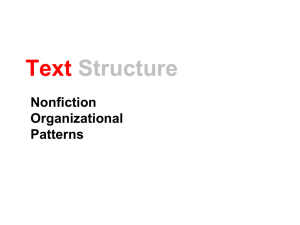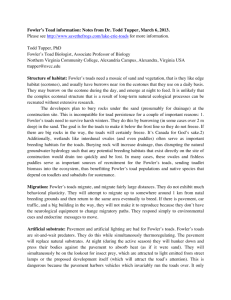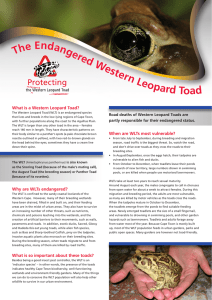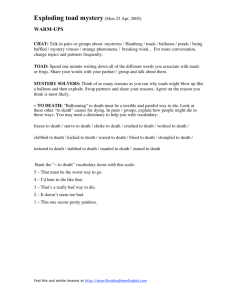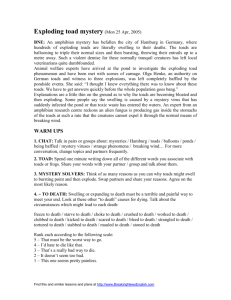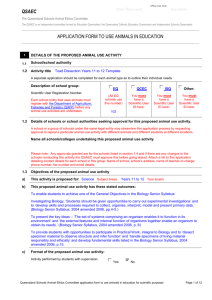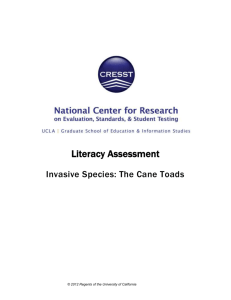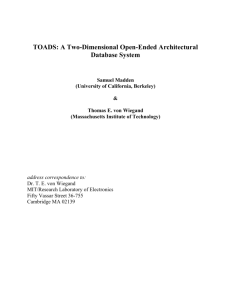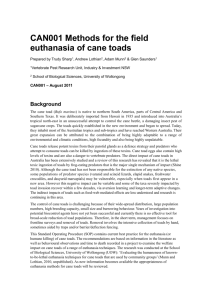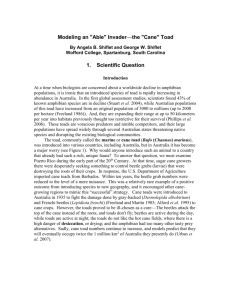Informational Text - Oakland High School
advertisement
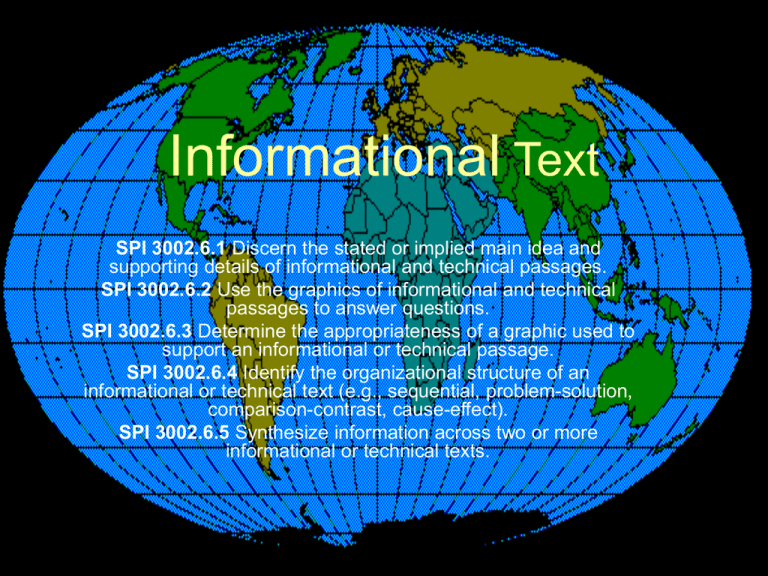
Informational Text SPI 3002.6.1 Discern the stated or implied main idea and supporting details of informational and technical passages. SPI 3002.6.2 Use the graphics of informational and technical passages to answer questions. SPI 3002.6.3 Determine the appropriateness of a graphic used to support an informational or technical passage. SPI 3002.6.4 Identify the organizational structure of an informational or technical text (e.g., sequential, problem-solution, comparison-contrast, cause-effect). SPI 3002.6.5 Synthesize information across two or more informational or technical texts. Finding the Main Idea • The Main Idea or central point of any passage can be found in two different ways. – Stated – Directly stated in a topic sentence. Topic sentences can be found in the title, the introduction, or even the beginning or ending sentence of a paragraph. – Implied – an author may show the main idea by implying, hinting, or suggesting it through details and facts. Supporting ideas • Supporting details give more information about the main idea. • Details are items of information that answer the 5 W’s and H of journalism: Who? What? Where? When? Why? and How? • These fill in information and explain the main idea. Tips for Finding a Stated Main Idea 1. Read the title. 2. Read the first and last sentence of each paragraph. 3. Choose the answer that is the best statement or restatement of the passage’s main idea. 4. Always read the entire passage. Discern the Main Idea The Mockingbird “Mockingbirds are common and popular birds in the eastern and southern regions of the United States. The mockingbird is the state bird of Arkansas, Florida, Mississippi, Tennessee, and Texas. “Mockers,” as they are affectionately called, are known for their ability to mimic other birds, mammals, and insects with song and sounds. Mockingbirds often live close to human homes, nesting in ornamental hedges. Tips for Finding Implied Main Ideas 1. Read the title. 2. Read the entire paragraph or passage. This will give you a general understanding. 3. Reread the facts and details in each paragraph. Think of the overall idea that they have in common. 4. Choose the answer that summarizes all of the facts and ideas in the passage. Check the evidence in the passage one more time. What season is it? “Outside, the wind was bitterly cold, and the snow was piling up quickly.” Winter How do you know? QUIZ Putting Energy Back into Your Life Are you getting enough water? Think of your houseplants. When they are short on water, they droop. The same thing happens to you! Your body is made up of millions of cells, and the principal part of each cell is water. If your cells are low on water, you will function at less than full efficiency. Strive for six to eight glasses of water each day. 1. What is the implied main idea of this paragraph? a. b. c. d. Houseplants need water to survive Cells contain a high percentage of water Our bodies are made up of millions of cells Your body needs water to remain efficient Using graphics to answer questions • Non-print media (photographs, illustrations, and graphics) can be a useful and powerful tool. Images can be used like words—to inform, to entertain, to inspire, to prompt action, to symbolize, or to capture a moment in history. They can sometimes show information more clearly than words. Look at the diagram below. Which factual detail belongs where the circles overlap? a. Independent b. must be fed c. Need to potty train d. funny to watch Is the graphic appropriate for the text? Using visual elements helps with research and decision making. Understanding how various visual elements work will help you determine the appropriateness of each. Line graphs • Show how things change over time. They often compare trends or show how two or more events affect each other. What questions can we ask about this chart? What thesis might it support? drug-use-chart.gif schooldrugtesting.com Bar Graph What do the numbers on the side represent? What thesis statement might this graph support? What conclusions can we make based on this information? • Usually compare amounts of items in different categories. A bar graph can also show different quantities or changes over time. Pie Charts • Used to show the various parts of a greater whole. Many times, they are helpful in showing how many people favor each opinion on a given issue. Using the 2007 Treatment Episode Data Set (TEDS), this report examines the characteristics of female substance abuse treatment admissions aged 12 to 17. In 2007, of the nearly 132,000 admissions aged 12 to 17, approximately 30 percent or slightly more than 40,000 were female admissions. Among female adolescent substance abuse treatment admissions, 19 percent were aged 12 to 14 and 81 percent were aged 15 to 17. More than half (58 percent) were non-Hispanic White and nearly one fifth (18 percent) were Hispanic (Figure 1). Another 13 percent were non-Hispanic Black. Tables • Meant to help readers easily find and compare information. They show data arranged in rows and columns. The rows of a table go across; the columns of a table go up and down. The table heading, usually found at the top of the table, describes what information is contained in the table. It also tells you where you should look to find exactly the information you need. Quiz 1. Hayley is looking at her class schedule for this semester. It shows all her classes, class times, and class locations in separate rows. How is this information most likely presented? a. In a line graph b. in a bar graph c. In a table d. in a map • The title of Cameron’s paper is “The Inner Workings of Formula-One Cars.” Which graphic would be the best addition to support the information in this paper? A. a table of winning Formula-One racers B. a cutaway that shows the engine parts C. a map showing the race track D. a sidebar of racing terms Read the following magazine advertisement. Do you dread doing the dishes? Harsh dish detergent can dry out your hands and nails, leaving your skin rough and cracked. Save your hands and use Luv Doing Dishes instead. Luv Doing Dishes promises to be tough on dishes, but gentle on hands. Which image would be the best addition to the advertisement? A. a photograph of a woman’s manicured hands B. a photograph of a sink full of dirty dishes C. a line graph showing the product’s sales D. a map showing where the product is sold Assignment Choose something in this room. Write an advertisement for it. Describe a graphic that would support this advertisement. Now, write an article about the object. Show the product over time: sales, deterioration, usage, etc. You choose. Draw a graphic that would support this article. Link to text structure • text-structure power point.ppt Identify the organizational structure of a text • It is important that you understand how an author is communicating his or her ideas. Knowing how a text is organized can tell you a lot about what an author is saying • When organizing an essay, look for a clear progression of ideas. The most effective order of sentences may be according to the time they happened, the best sequence of actions to take, which points are most important, or a causeeffect relationship. Sequential/ chronological • Starts from the first, then second, then third, etc. Moved Fell in MetinGirl • Also used expository Away Love writing, which sometimes explains how something works. Which graphics might support this organization? •Key words: Born•first Married in 1882 in 1906 •third •before •then •next •finally •second •when •after •last •until •between •now •later •afterwards •most important Died in 1948 Problem/solution • Writers will often explain a problem then pose solutions that they hope the audience will accept and support. Problem solution order begins with the problem. • What are the details of the situation? • Who is affected by the problem? • Why should an audience care about this particular dilemma? Which organizational chart would help you to prepare for writing this type of essay. • As a writer, you must present the problem and support your claims with details that explain why a solution is necessary. Otherwise, you’ll lose audience support before you get a chance to offer solutions. Order of Importance • Some details need to stand out. Emphasize certain ideas by placing them at the beginning or the end of a paragraph. • Sometimes you will want to start with the most important idea. Other times you will want to save the best idea for last. Example of Order of Importance Dear Aunt Jenny, I really would likeWhat to spend the summer would be awith you because I have never Why? spent much time in Oregon. Also, I am interested in earning some better waysavings, to extra money for my college and many jobs are available in your area. Most importantly, I really enjoy our short visits when we organize this? get together over the holidays, and I want to spend more time with you so we can be closer. Please write back soon, and let me know what you think. Love, Sandra Be persuasive Comparison/contrast order • Sometimes in writing you will need to choose one side of an issue and convince Apples & the reader of the validity Oranges of your position. • Comparing your ideas with other popular ideas can help you accomplish this. • Another wayFruits to convinceColors readers to agree Have Seeds Tastes your position with your views is to contrast Healthy pointing Locations with its opposite, out differences and showing why your position is better. Example • Household pets suchQuiz: as catsChoose and dogscat can bring families ORpeople dog. prefer Writeone a or the other, I a lot of joy. While many think that both cats andparagraph dogs make that excellent family pets. Cats and dogs are very playful, the especially contrasts other when they are kittens and puppies. They provide their owners with to emphasize your endless entertainment, performing silly tricks and setting off on many household adventures. position. Cats and dogs also bond with family members, seeking out attention and affection from What isMost the families What is their the human companions. with cats and dogs find that their pets enrich their lives author’s everymain day. idea? position/view? Cause/effect Order is the • Cause – Reason for anWhat event effect? • Effect – result of the event What is –the • Example Last night you stayed up late What chain of cause? finishing a project for school. This events might morning you were so tired happen that you didn’t hear your alarm clock. because of the cause? Practice Deviled Eggs Pop out (remove) the egg yolks to a small bowl and mash with a fork. Add mayonnaise, mustard powder, vinegar, salt and pepper and mix thoroughly. Fill the empty egg white shells with the mixture and sprinkle lightly with paprika. Cover lightly with plastic wrap and refrigerate for up to one day before serving. 2 Sports at Ericson There are two popular sports played at Ericson, basketball and volleyball. Both take place inside of the gym at Ericson. Also, each sport has two teams of people. In basketball, however, the ball can be played off of the floor, and in volleyball, the ball cannot touch the floor or it is out of play. Basketball and volleyball are popular sports at Ericson. 3 The Lazy Student When Tim woke up, he didn’t want to go to school. His mom took him anyway. So, he went to school, but he didn’t do any work. The days passed, and Tim still didn’t do any work. Mr. Morton called Tim’s house, but Tim still wouldn’t do any work. Finally the report cards came out, and Tim failed his classes. Tim was sad. 4 Failing Classes Lots of students fail classes. Some students fail because the work is too hard for them. Other times they may fail because they are lazy, and don’t do any work. Another reason why students may fail is if they don’t go to school. If you’re not in class you may miss a lot. Many students fail classes every quarter. 5 Passing Classes A lot of students have been failing classes. These students wouldn’t be failing classes if they studied more, asked questions, tried harder, and came in for extra help. Even though a lot of students fail classes, they have many options if they want to pass. 6 Gail Denvers Devers experienced the highlight of any sprinter’s career, as she stood on the huge platform in the giant stadium and received an Olympic gold medal. Eighteen months earlier she wasn’t thinking about running. She was hoping that she would be able to walk again. Just four years earlier, in the summer of 1988, as Devers was training for the Olympic Games, to be held in Seoul, South Korea, she began to feel very tired all the time and failed to make the Olympic finals. 7 » Three Types of Circus Clowns » Generally, there are three categories of circus clowns—whiteface, august and character. Each has a specific makeup style and costume. Each has a typical act as well. » The neat whiteface is usually a strict, in-charge character who sets up the punch line for the joke with a partner His facial features are neatly detailed in red or black. Circus legend has it that the august clown got his name from a German nickname for someone who is clumsy. The august wears light-colored makeup, but white is used around the mouth and eyes, and there’s a big red nose. This clown performs a great deal of slapstick humor. Character clowns perform as different personalities—cowboys, scarecrows, grandmothers or symphony conductors. The most famous character clown, however, is the tramp. Tramps wear different styles of makeup and costumes that are torn or shabby. Some tramp clowns are happy-go-lucky. Others are extremely sad. Still others act like gentlemen who just happen to be out of money. 8 HOW TO USE THE MICROSCOPE 1. Plug in the lamp. 2. Place a sample of what you wish to observe on a slide. 3. Adjust the mirror so it reflects light from the room up into the objective lens. 4. Place your slide with the specimen directly over the center of the glass circle on the stage. 5. With the LOW POWER objective lens placed over the slide, use the coarse focus knob. 6. Look through the eyepiece with one eye while closing the other eye. 7. Use the fine focus knob to fine 9 Fewer Toads Though toads are still around, they no longer are as common in some areas as they were a few decades ago. The growing use of insecticides has reduced their numbers. The chemical sprays usually do not harm toads, but cut down the animals’ food supply. Thereby, the toads do not have enough food to survive. There are fewer toads in many areas populated by humans. 10 Restoring the Toad Dr. Knapp doesn’t want people to sit back and let the toad vanish. He believes that everyone is responsible for restoring the toad species. Dr. Knapp thinks we could help restore the toad population if we stop mowing parts of our lawns and let the grass grow wild to reserve space for the toad. He also believes we need to stop using pesticides and fertilizers. The chemicals kill the insects that toads eat. If we preserve some spaces in our lawns and stop using fertilizers, Dr. Knapp believes we can save the toads. Answers 1. 2. 3. 4. 5. 6. 7. 8. 9. 10. Sequence Compare and Contrast Chronological Cause and Effect Problem and Solution Chronological Compare and Contrast Sequence Cause and Effect Problem and Solution Synthesize Information • When you are trying to understand a concept or working on a research project, you often use material from a variety of sources. In the end, you must decide how these sources will fit together to create a whole, complete idea. Steps to synthesizing information across texts/graphic 1. Identify the main idea of each text/graphic 2. Identify similarities – What do each have in common? 3. Identify differences – How do they differ? 4. Draw conclusions – How will you use this information to support your own theories/ideas or to simply answer questions? See page 181-185 in purple book for practice Synthesize When trying to find your way around town, you must SYNTHESIZE information from maps, instructions, and time schedules. Rover Let’s take a look. How would you find your way down town? Honors assignment • Read 5 articles from the 5 main Republican candidates in the 2012 election campaign. Each article discusses jobs and the economy. I have omitted the names of the campaigners so that you have may view their ideas more objectively. • Take notes on each article – – – – – Write the number of the article. What is the main idea? Which organization structure is used? How are they similar and different from each other? What are the pros and cons of the ideas? What do you like/dislike? What do you think will work/not work and why? • Synthesize the information in a paragraph that discusses which candidate you would most likely vote for (if you could) based solely on these articles. Use the articles and your own ideas to support your main idea. *You may not say none of them. Sorry, just choose.
